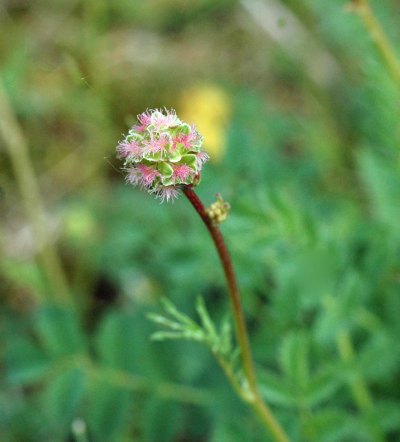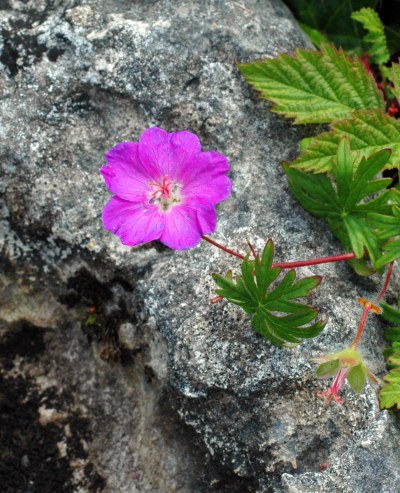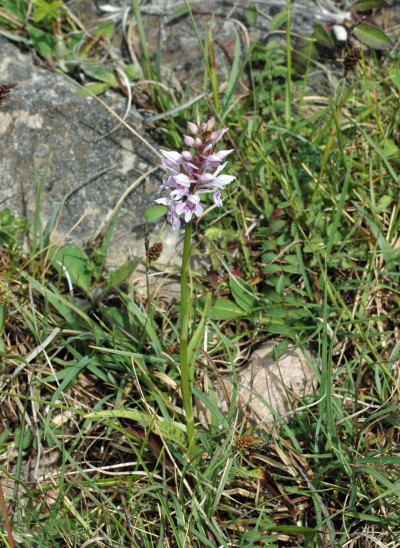Tags
bloody cranesbill, Brown Argus, common blue, common rockrose, common shrew, dropwort, heath-spotted orchid, limestone pavement, North Wales Wildlife Trust, salad burnet, small heath, wildflowers of Bryn Pydew
The North Wales Wildlife Trust reserve at Bryn Pydew is becoming one of my new favourite places to visit, especially to see some of our less-common wildflowers and a variety of insects.
The first thing to attract my attention today was a Small Heath butterfly. Fluttering along low to the ground it kept disappearing from my sight as it landed amongst the stems of long grass, but I managed to follow it along the woodland edge for a short way until I was distracted by the corpse of a little shrew. It didn’t appear to have been there for long, but there were puncture wounds around its back so had clearly been caught by something with sharp teeth and the fact that it had not been eaten suggests a domestic cat; they don’t like the taste of shrew and often leave their victims lying at the side of paths etc.
Common Shrew – Sorex araneus Welsh: Llyg Cyffredin
British shrews are protected by the Wildlife and Countryside Act 1981, and it is an offence to kill them without a special licence.
Description: As with all shrews, the common shrew has a long, flexible snout, small eyes and tiny ears. They have dark brown fur on their backs, paler sides and an even paler underside. Their heads are not as domed in shape as that of the even smaller pygmy shrew and the tail is proportionately shorter than that of the smaller species.
Food: All shrews have voracious appetites; they need to feed every 2-3 hours and consume up to 90% of their body weight in any 24 hour period. They eat most terrestrial insects, but also take worms, slugs and snails; they have a good sense of smell and feeling, but they do not dig for their prey.They lack the fat reserves to see them though the winter so do not hibernate and can be seen all year round. Apart from those killed by cats, shrew corpses may also be those of animals that have not been able to find enough food.
Behaviour: They are solitary, territorial animals and often fight when they come into contact with their neighbours. The high pitched squeaking sound that they make can often be heard as you walk along footpaths; they are most active at night and during dawn and dusk and intersperse periods of intense activity with resting.
Reproduction
Shrews build nests below the ground or under dense vegetation. After a gestation period of 22-25 days, females give birth to 4-7 young, which are weaned after 22 days. They breed from April to October, with a peak in the summer.
_______________________________________________________
I lost the butterfly but was soon compensated with a lovely bright metallic green beetle rummaging around in the stamens of a Welsh poppy.
This was the first, rather hasty photograph I took of the handsome beetle and followed it with a number of what I thought would be much better shots, but when I downloaded the day’s bounty I discovered all of them were unreadable, so goodness knows what happened there. Hopefully I will find more another day.
The open patch of ground just inside the site boundary is lovely now, lush with a mix of tall meadow grasses swaying gently in the day’s light breeze and catching the sunlight. Dog rose shrubs are in glorious full bloom.
In a sunny patch of shorter turf where there was Red Clover and Bird’s-foot Trefoil growing I stopped to watch Common Blue and Brown Argus butterflies and bumblebees. Both species of butterfly are territorial despite their tiny size and were chasing off anything and everything that dared enter their airspace.
There’s not much to see in the woodland here, the trees, including a good number of yews grow closely together, shutting out much of the sunlight, so it is very dark and quiet in there. I did spot a young Wren demanding attention from a parent though, calling loudly and flapping its wings wildly to try to maintain its balance on a fence post. It is only a short downhill walk to take before reaching the open area of Limestone Pavement. It’s a little more overgrown now than the last time I saw it, with quite a few tree saplings and brambles getting a foothold. I know little or nothing about how you would go about maintaining a limestone pavement though, so have no idea what would be removed, or when, but there are some lovely wildflowers here currently and it would be a shame if they were smothered by brambles.
There is quite a bit of rockrose, interspersed with salad burnet with its curious flowerheads.
Salad Burnet– Sanguisorba minor is a low-growing herb of chalk and limestone grasslands which produces rounded, reddish flower heads from May to September. The leaves of Salad Burnet comprise up to 12 pairs of rounded, toothed leaflets, and form a rosette at the base of the flower stem. The rounded flower heads are reddish and speckled.
The leaves are famous for smelling of cucumber if crushed or walked upon, and this plant lives up to its name as a popular addition to salads and summer drinks.

The leaves of Salad Burnet comprise up to 12 pairs of rounded, toothed leaflets, and form a rosette at the base of the flower stem.
I try not to plan my outings too much, preferring to take things as they come at the time, but I was hoping to find one of this site’s ‘special’ plants in flower today. Dropwort-filipendula vulgaris is a clumsy (pardon the pun) name for a very elegant and rather ‘frothy’ plant. I found a couple of stems at the end of their flowering late last summer, but hoped to find more today. I was pleased then to find the first ones, which I recognised by the pretty fern-like leaves, but alas the flowers were still tightly budded. Once I had spotted one I found more, but all were tightly closed.
Again there was compensation for not finding what I was hoping for; this time it was Bloody Cranesbill –Geranium Sanguinem, which is not at all a common plant and in Wales restricted to a few limestone-rich coastal areas. It grows also on the Great Orme, a few miles away in Llandudno and I have also seen it on Llanddwyn Island in Anglesey.
There are many colour variations of this plant species, but it takes the ‘Bloody’ part of its name from the blood-red sepals that remain after the petals have fallen.
Leaving this main area of the limestone pavement and continuing downhill through a narrow belt of woodland you emerge into an open grassy area that is so pretty I was half-expecting Bambi and friends to pop out. There were a few Purple Spotted Orchids here, very nearly finished, an impressive group of Bloody Cranesbill and more Rockroses.
At the far end of this small woodland glade is another smaller section of pavement, which is where I found the Dropwort last year. There was no sign of the plant in the exact same place, but I did spot a couple of little pale pink orchids. Once again, as I got my eye in, I found more of them, most not quite fully out yet.
I sat in the sunshine on the edge of the rocky pavement for a while, admiring the view across to Penrhyn Bay and watching more Small Heath butterflies fluttering over the stony ground where they settled to bask occasionally. I realised then that the reason I was finding it difficult to spot them earlier was because they settle very low to the ground, almost horizontal to it. As I got up to leave one fluttered along the grass in front of me, settling some metres ahead, so I took a series of photographs as I inched towards it, each one a little closer. It allowed me to get very close before flying off from here.
Quite unexpectedly then, just a short distance away from the butterfly I glanced up to see the flower I was hoping for in peachy pink and creamy white frothy glory. A Dropwort in almost full glorious bloom. What a treat.
Dropwort (Filipendula vulgaris), also known as Fern-leaf Dropwort, is a perennial herb of the family Rosaceae and closely related to Meadowsweet. It is found in dry pastures across much of Europe and central and northern Asia, preferring full sun to partial shade and is more tolerant of dry conditions than most other members of its genus.
It has finely-cut, radical leaves, fern-like in appearance, and an erect stem 20–50 centimetres (8–20 in) tall. The tiny creamy white flowers appear in dense clusters from late spring to mid summer. The crushed leaves and roots have a scent of oil of wintergreen (Methyl salicylate).


















Beautiful. Next time we get up north we should try to visit this place. We were at Dyrham Park, near Bath today, about to blog some pics.
LikeLike
Thank you, it is a lovely site, probably at its best now. It’s a ridiculously long haul South to North isn’t it? No straightforward road through the middle! Looking forward to your pics, hope you had a good day out.
LikeLike
Thank you Sam. As you say, this Bryn is close to Colwyn Bay, more accessible from its Penrhyn Bay/Llandudno side. This whole area is wonderful for learning about natural history, there is so much diversity I’m finding it hard to keep up myself, but loving the experience. PS-There is more info about the sites I visit on ‘pages’ of the blog, including directions to Bryn Pydew, for anyone wishing to visit it themselves.
LikeLike
I enjoyed reading this post. So much natural history that I’ve still to learn! I’ve just goofled Bryn Pydew and found that it’s closer to Colwyn Bay than I’d realised. I used to work in Colwyn Bay, as it happens. In case any of your readers don’t know the area, here’s some info about this nature reserve http://www.first-nature.com/waleswildlife/n-nwwt-brynpydew.php
LikeLike
I can’t see or hear limestone-pavement mentioned without getting terrible flash-backs to crossing Malham years ago after about twenty miles of rainy walking – you can see I was traumatised! But what a lot of interesting things to see. I suspect you’re having considerably better weather than us, still doing a good attempt at late winter here – not conducive to long outings. Glad to have yours to fill the gap!
LikeLike
Sorry about the flashbacks! I imagine keeping your balance on wet limestone pavement is a bit of a challenge; it’s bad enough when it’s dry. Weather has been pretty good here, last couple of days rainy and cooler. Will try to keep you provided with some ‘armchair rambles’ for entertainment on grotty days!
LikeLike
Armchair rambles gratefully received!
LikeLike
Very nice selection of wild flowers, but I really like your blues. I’ve seen so few of them hear since 2010 and I was hoping to see more this year… but not so far.
LikeLike
Thank you Finn. I’ve always wondered how these beautiful little butterflies came to be named ‘Common’-other than that they occur in most areas, I’ve never found them numerous, particularly as with you, in recent years. On that afternoon I saw just the one male and maybe 3 or 4 females. We’ve bumper crops of bird’s-foot trefoil here this year, so ample larval food. Finger’s crossed for a good year for them.
LikeLike
Poor shrew. I hadn’t seen dropwort before – it’s so pretty.
LikeLike
I know, I hate finding dead things. It seems a bit macabre to put the photo in, but it gave the opportunity to mention shrews and quite honestly I doubt I’ll ever get a shot of a live one! The Dropwort is gorgeous isn’t it – like hawthorn, very ‘bridal’.
LikeLike